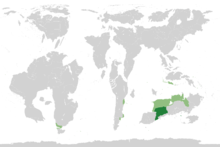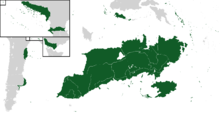Difference between revisions of "South Staynes"
| Line 47: | Line 47: | ||
South Staynes declared independence from the [[Morstaybishlian Empire]] on the 6th of June, 1975, due to [[Staynes]] (one branch of the Empire) becoming economically and militarily weak, which could not maintain the region. It later had no other options but to reinstate member status of the empire after several years borderline anarchy. The nation now struggles to keep its inhabitants happy due to the low income per person. | South Staynes declared independence from the [[Morstaybishlian Empire]] on the 6th of June, 1975, due to [[Staynes]] (one branch of the Empire) becoming economically and militarily weak, which could not maintain the region. It later had no other options but to reinstate member status of the empire after several years borderline anarchy. The nation now struggles to keep its inhabitants happy due to the low income per person. | ||
| + | ==Poverty crisis== | ||
| + | |||
| + | South Staynes has always suffered with high income inequality. In 2016, approximately eighty percent of the population live off of the land, generally as farmers in hobbit style houses trading in food and possessions as they cannot sustain themselves in the system. The other 20% live in the system as a functioning government body and population. A system integration program was established in 2005 to try and sway more people to move to urbanised areas and live above or at minimum wage according to ACA standards. However, this has only resulted in a small percentage of people converting. | ||
[[category:Aurora]] | [[category:Aurora]] | ||
[[Category:Morstaybishlia]] | [[Category:Morstaybishlia]] | ||
Revision as of 10:41, 13 April 2017
| This page is a work in progress by its author(s) and should not be considered final. |
| The Republic of South Staynes | ||||
|---|---|---|---|---|
|
||||
| Motto: The Mountains, our protector. The Hills, our home. | ||||
| Anthem: "Power of Mother Hill." | ||||
South Staynes and its dependencies in dark green, other Empire territories in light green.
|
||||
Regional Map showing South Staynes.
|
||||
| Capital | Kirdintayos | |||
| Largest city | Labius | |||
| Official languages | (By first language) Old Staynic 44.9% Staynish (Simplified) 26% Kirdintay 11.3% New Axdelian 8.43% Corstanese 4.117% Lishboyara 3.8% Labian 1.4% Jubliakese 0.05% Rekliese 0.003% |
|||
| Ethnic groups (2016 Estimate) | 97% Human 3% other | |||
| Demonym | South Staynese, South Staynish | |||
| Government | Republic (Monarch figureheads) | |||
| - | High-King | Lambertus VII Constantine | ||
| - | Prime minister | Frode Humblack | ||
| Legislature | National assembly | |||
| Population | ||||
| - | 2017 estimate | 160,384,000 | ||
| - | 2015 census | 158,905,010 | ||
| GDP (nominal) | 2017 estimate | |||
| - | Total | SS♅1,465,619,360,071 | ||
| - | Per capita | SS♅9,138.18 | ||
| Currency | South-Staynish Kirib (SS♅) |
|||
| Date format | DD/MM/YYYY | |||
| Drives on the | the left | |||
| ISO 3166 code | SST | |||
| Internet TLD | .sst | |||
South Staynes, referred to as The Republic of South Staynes, is a moderately large sized nation in central Aurora, known by its hilly lifestyle and chilly, jagged coastline, has a rough population of about 160 million. It is noted that around 6,000,000 people live in the city of Labius. It neighbours are Staynes, Axdel, which it shares the largest border with, MMH, and Ethalria. The Isle of Rek, which is one of the oldest settled islands in Aurora, neighbours Tuvaltastan, Imperial Fandom & Dragonia.
South Staynes declared independence from the Morstaybishlian Empire on the 6th of June, 1975, due to Staynes (one branch of the Empire) becoming economically and militarily weak, which could not maintain the region. It later had no other options but to reinstate member status of the empire after several years borderline anarchy. The nation now struggles to keep its inhabitants happy due to the low income per person.
Poverty crisis
South Staynes has always suffered with high income inequality. In 2016, approximately eighty percent of the population live off of the land, generally as farmers in hobbit style houses trading in food and possessions as they cannot sustain themselves in the system. The other 20% live in the system as a functioning government body and population. A system integration program was established in 2005 to try and sway more people to move to urbanised areas and live above or at minimum wage according to ACA standards. However, this has only resulted in a small percentage of people converting.



